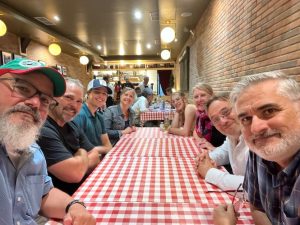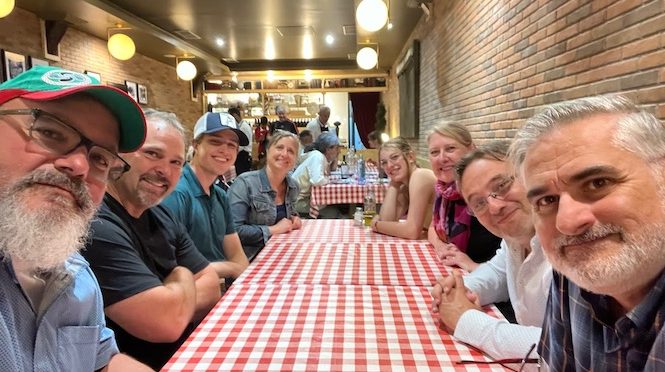The next day, after visiting Munitibar, we spent the day in Bilbo. When I was living in Donostia in 1991-92, Bilbo wasn’t the biggest attraction. It had a reputation for being big and dirty. But, the city has really transformed itself, in part due to the Guggenheim effect. We met up with Pedro Oiarzabal, the heart of the Fighting Basque project, and my old friend from my Seattle days Aitor Pina in the Casco Viejo or Zazpi Kaleak neighborhood. We wandered the Plaza Nueva, getting a few drinks and pintxos and then strolled past the unending streets of shops. Pedro told me how the pintxo scene is changing. Before, people would get one pintxo at a bar and then wander to the next. But tourism is shifting that, such that people get a whole meal of pintxos at one place – enticed by 2-for-1 type deals – and end up just staying at one bar. I’ll be a grumpy old man and say I like the old way better.

- When Bilbo was founded in 1300, there were two neighborhoods that straddled the Nervión River. On the left bank was Bilbao la Vieja and on the right what became the Casco Viejo. While La Vieja was a mining center with forges and the like, the Casco Viejo was the port, focused on water traffic.
- Originally, the Casco Viejo was surrounded by a wall that enclosed three parallel streets. However, with growth, more room was needed. The wall was torn down and four more streets were added, bringing the total to seven and giving the neighborhood its other name – Zazpi Kaleak or Seven Streets: Somera (Goienkale, or the street above), Artekale (the middle street), Tendería (Dendarikale, the street of shops) – these are the three original streets – Belostikale, Carnicería Vieja, Barrenkale, and Barrenkale Barren. New walls were built around this expanded core, though that was eventually replaced by another street, the Ronda.
- In 1979, the neighborhood was made pedestrian-only and it has become a commercial center of the city, containing some 240,000 square meters (2.5 million square feet) of restaurants, bars, and stores.
- In 1983, the whole neighborhood and beyond was devastated by a massive flood. Something like 2 feet of rain fell in 24 hours, this after a month of steady rains that saturated the earth. Water levels, marked on some of the buildings to remember the horrific event, reached higher than the first floor of the buildings, putting the ground level shops and bars completely under water. 34 people died. Some 101 cities around the Basque Country were damaged by the rains and floods. The Casco Viejo was destroyed, but with time it was rebuilt and has become the commercial and social center of Bilbo that it is today.
- At the time of Bilbo’s founding, the Casco Viejo already had the fortress of San Antón which would become the Church of San Antón and temple of Santiago, which is, today, the Cathedral.
- One of the Basque Country’s most celebrated composers, Juan Crisótomo de Arriaga, was born on the oldest street of the Casco Viejo – Goienkale. And not far away is the oldest house in Bilbo. While the exact date of its construction has been lost, it was at least in the 14th century. It is still inhabited. And, on Calle Ronda, the famous intellectual Miguel de Unamuno was born on September 29, 1864. And the first Lehendakari of Euskadi – José Antonio Aguirre y Lecube – was also born in the Casco Viejo, in 1904.
- The Plaza Nueva, where I met Pedro, was also known as the Venice of Euskadi. In 1871, when King Amadeo I visited the city, the city blocked off the plaza and the entrances to the buildings and flooded the plaza, even bringing in gondolas and asking the people of Bilbo to dress like gondoliers, to mimic Venice. All this because Amadeo was of Italian origin.
Primary sources: Casco Viejo y Ensanche, Bilbao Turismo; Historia del Casco Viejo, Casco Viejo; Bilbao por sus calles y plazas: Curiosidades de su emblemático casco viejo, National Geographic; El día que Bilbao fue sepultada por el lodo, La Vanguardia
Discover more from Buber's Basque Page
Subscribe to get the latest posts sent to your email.



One thought on “Basque Fact of the Week: The Casco Viejo of Bilbo”